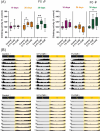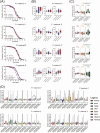Curcumin Induces Transgenerational and Sex-Specific Effects on Lifespan, Gene Expression, and Metabolism in the Fruit Fly Drosophila melanogaster
- PMID: 40751014
- PMCID: PMC12317048
- DOI: 10.1002/biof.70039
Curcumin Induces Transgenerational and Sex-Specific Effects on Lifespan, Gene Expression, and Metabolism in the Fruit Fly Drosophila melanogaster
Abstract
Curcumin is a bioactive compound found in turmeric (Curcuma longa) and is widely recognized for its health-promoting effects, including anti-inflammatory, antioxidant, and anti-carcinogenic properties. It can also mediate epigenetic effects by inhibiting histone acetylases (HATs) and deacetylases (HDACs) but the transgenerational context has not been studied in detail. Here, we used the fruit fly (Drosophila melanogaster) as a model organism to determine the epigenetic effects of 0.1% and 1% (w/v) curcumin, which have been shown to promote the health and prolong the lifespan of fruit flies. Both concentrations were found to significantly increase lifespan and climbing activity in male and female flies, but changes in HAT/HDAC gene expression and metabolism were sex-specific. Unexpectedly, the F1 offspring of curcumin-treated parental flies showed a significant reduction in lifespan that was also sex-specific, as well as sex-specific and dose-dependent transgenerational changes in HAT/HDAC gene expression and metabolism. These results show that curcumin's beneficial effects in the parental generation are followed by deleterious effects in the offspring, highlighting the need to further investigate the potential transgenerational effects of nutrients and bioactive compounds that are used as dietary supplements for humans.
Keywords: Drosophila melanogaster; aging; curcumin; epigenetics; nutrition; sex‐specific; transgenerational.
© 2025 The Author(s). BioFactors published by Wiley Periodicals LLC on behalf of International Union of Biochemistry and Molecular Biology.
Conflict of interest statement
The authors declare no conflicts of interest.
Figures




References
-
- Goel A., Kunnumakkara A. B., and Aggarwal B. B., “Curcumin as “Curecumin”: From Kitchen to Clinic,” Biochemical Pharmacology 75 (2008): 787–809. - PubMed
-
- Esatbeyoglu T., Huebbe P., Ernst I. M. A., Chin D., Wagner A. E., and Rimbach G., “Curcumin—From Molecule to Biological Function,” Angewandte Chemie International Edition 51 (2012): 5308–5332. - PubMed
-
- Kocaadam B. and Şanlier N., “Curcumin, an Active Component of Turmeric (<styled-content style="fixed-case"> Curcuma longa </styled-content>), and Its Effects on Health,” Critical Reviews in Food Science and Nutrition 57 (2017): 2889–2895. - PubMed
MeSH terms
Substances
LinkOut - more resources
Full Text Sources
Molecular Biology Databases

